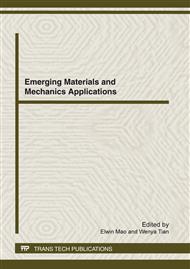p.171
p.176
p.181
p.186
p.192
p.198
p.203
p.208
p.212
Study on Themal and Rheological Properties of POM
Abstract:
Polyoxymethylene is a linear polymer with excellent performance due to its chemical structure and high crystallinity. The thermal and rheological properties of POM are investigated in this paper. Experimental results indicate that the melting point and decomposition temperature of POM are about 162 °C and 266 °C respectively. POM melt is a non-Newtonian fluid, the apparent viscosity gradually decreased with the increase of shear rate, showing a typical shear-thinning behavior. Non-Newtonian index increased from 0.53 to 0.61 as the melt temperature increased from 190 °C to 230 °C. The flow activation energy of POM melt is between 11.36 and 24.90 kJ/mol within the shear rate range of 90~2500s -1.
Info:
Periodical:
Pages:
192-197
Citation:
Online since:
March 2012
Authors:
Price:
Сopyright:
© 2012 Trans Tech Publications Ltd. All Rights Reserved
Share:
Citation:


